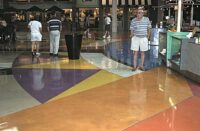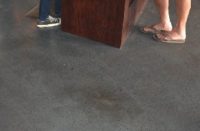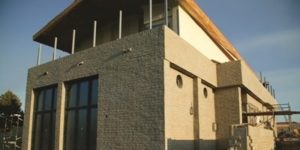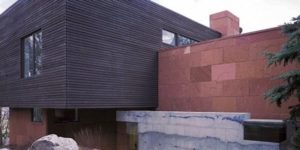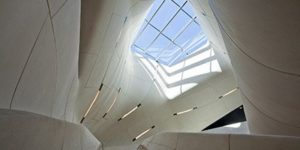
It is said that necessity is the mother of invention, and this rings true in many situations where a new decorative concrete technique is born out of a difficult situation. Whether it’s a tight timeline or budget, finding a new way around the same old thing makes all the difference.
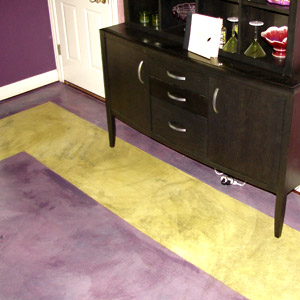 In a recent project at the Griffiths home, a colorful house located in New Braunfels, Texas, Details Decorative Concrete employed a technique they’d previously developed themselves. The company has created and developed many decorative concrete projects from scratch, but this home was different: It contained many interior decorative concrete surfaces already in place, including floors, tub and shower, but all of them needed to be refurbished in order to reflect the client’s tastes. The typical techniques used when starting from scratch weren’t going to work.
In a recent project at the Griffiths home, a colorful house located in New Braunfels, Texas, Details Decorative Concrete employed a technique they’d previously developed themselves. The company has created and developed many decorative concrete projects from scratch, but this home was different: It contained many interior decorative concrete surfaces already in place, including floors, tub and shower, but all of them needed to be refurbished in order to reflect the client’s tastes. The typical techniques used when starting from scratch weren’t going to work.
“The floors in the home were plain-Jane stained concrete,” explains Details Decorative Concrete owner Melissa Cuthburt. “And the owner just hated them. She’s eclectic, loves bright colors, and needed the surfaces to correspond with the movement on the walls and throughout the house.”
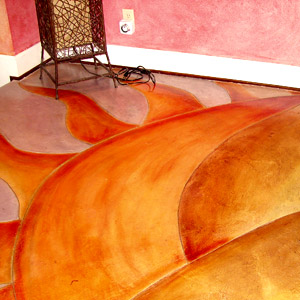 The home’s rusty-orange floors and deer antler chandelier, among other features, were typical of the hill-country Texas region. The new homeowner was an attorney who had relocated to the area and wanted something more imaginative and less in line with the local vernacular. She had already personalized the home with a huge, colorful mural and festively painted walls throughout, and was in search of a company that could come in and refinish her concrete floors to match. After speaking with just about every concrete finisher in the area and being told that she was stuck with how her existing floors were finished, she finally stumbled upon Details Decorative Concrete. Cuthbert’s interior design background suited her to create surfaces that tied in with and enhanced the home’s newly creative décor, but it was her ability to refinish the already stained concrete that made her a perfect fit.
The home’s rusty-orange floors and deer antler chandelier, among other features, were typical of the hill-country Texas region. The new homeowner was an attorney who had relocated to the area and wanted something more imaginative and less in line with the local vernacular. She had already personalized the home with a huge, colorful mural and festively painted walls throughout, and was in search of a company that could come in and refinish her concrete floors to match. After speaking with just about every concrete finisher in the area and being told that she was stuck with how her existing floors were finished, she finally stumbled upon Details Decorative Concrete. Cuthbert’s interior design background suited her to create surfaces that tied in with and enhanced the home’s newly creative décor, but it was her ability to refinish the already stained concrete that made her a perfect fit.
Several years ago, on a particularly challenging project, Cuthbert developed a technique that allowed dye and sealer to be applied together to already-finished concrete floors, creating a new finish on top of the old. Contracted by a local television station that was redecorating a set over a weekend, she faced an impossible deadline and minimal working time. Because the set needed to be ready for filming on Monday, contractors were given only two hours each over the weekend to finish their respective projects. When Cuthbert and her team arrived to finish the concrete floors, they discovered the set’s floor had been sealed every year for more than 40 years. It couldn’t be stripped, so they had to find another way to seal it with a new finish. They decided to mix dye in with the sealer and spray it on together. After applying several coats, it worked and the new finish stuck. What this told them, says Cuthbert, was that they could take concrete that couldn’t be stained and actually create a new look. They called the mixture of dye and sealant “intensifier.”
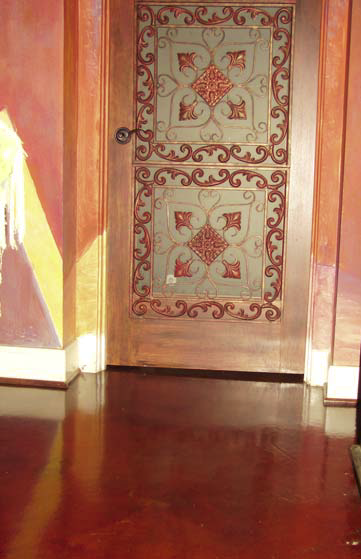 Fast-forward several years to the house in Texas. The technique allowed Cuthbert to take the boring plain-Jane floors and create a something new.
Fast-forward several years to the house in Texas. The technique allowed Cuthbert to take the boring plain-Jane floors and create a something new.
The client gave Cuthbert creative license to rejuvenate the floors in whatever way she saw fit. She started by stripping the concrete floors throughout the house and scrubbing them to fade the orange finish. She then mixed the dye for the new floor colors with the sealant and sprayed the mixture on the floors. The family room floors were intensified to a rich chocolate brown, and the dining room to a vibrant purple. For a bedroom, she created a Caribbean Ocean effect of varying shades of turquoise. Mixing blue and green dyes with the sealer, she sprayed a loose layer of the mixture over the orange floor, allowed it to dry, and applied another thin coat. If Cuthbert applied it too thickly, she says, she would have lost the mottled look and gotten a more uniform appearance. Applying in different areas in layers created the dappled, multicolored appearance of water.
For all the floors, the underlying orange was still visible after two coats, but had almost disappeared after the third. Workers then applied several layers of clear coat over the color to protect the surfaces.
For the foyer, Cuthbert wanted the floor to match the large mural, so she painted a large, brightly colored sun whose rays extend down the stairs. For stairs leading to the kitchen, she created a hacienda style with a tile effect by scoring the concrete for decoration before staining and dying differing colors. Using the intensifier, refinishing all the floors in the entire home took only about four days.
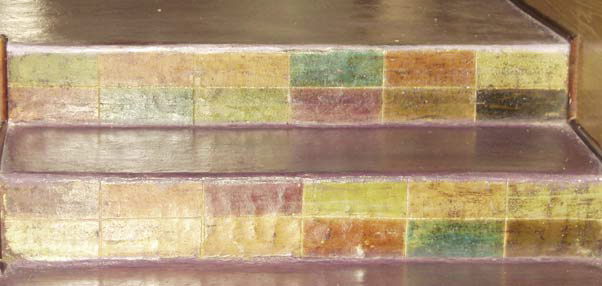 Cuthbert says that since discovering the intensifying technique, her crew uses it on about 75 percent of their projects.
Cuthbert says that since discovering the intensifying technique, her crew uses it on about 75 percent of their projects.
“Acid stain does what it wants to do on concrete; you have very little control,” she explains. “We sell this technique as ‘We can do what you want, as opposed to acid stain which is less controllable.’ The intensifier just provides such consistent color.”
Cuthbert also says it works great on surprise spots on floors that won’t take color for one reason or another. Because it’s so good for blending trouble spots and mistakes, it can be used on just about any project at any time.
 When approaching a project with intensifier, Cuthbert says, do a wax test first, regardless of what the client says has been done to the floors, because you never know if they have the floor’s whole story. If the intensifier is applied over wax, it will curdle and ruin the finish. She also says to be sure to use a quality sprayer and hose — the acetone in the dye can eat through a hose, causing it to unexpectedly break and spew dye. Also, they’ve found that because the dye usually doesn’t contain a UV protectant, the finish’s color can fade if used outdoors. They have experimented by putting several layers of clear-coat with UV protectant on some outdoor projects, and while it appears to work, the long-term effectiveness is still unknown.
When approaching a project with intensifier, Cuthbert says, do a wax test first, regardless of what the client says has been done to the floors, because you never know if they have the floor’s whole story. If the intensifier is applied over wax, it will curdle and ruin the finish. She also says to be sure to use a quality sprayer and hose — the acetone in the dye can eat through a hose, causing it to unexpectedly break and spew dye. Also, they’ve found that because the dye usually doesn’t contain a UV protectant, the finish’s color can fade if used outdoors. They have experimented by putting several layers of clear-coat with UV protectant on some outdoor projects, and while it appears to work, the long-term effectiveness is still unknown.
What is certain, however, is that new techniques are still evolving out of unique situations, allowing for homes to be rejuvenated and customized with much less work than would normally be expected.
